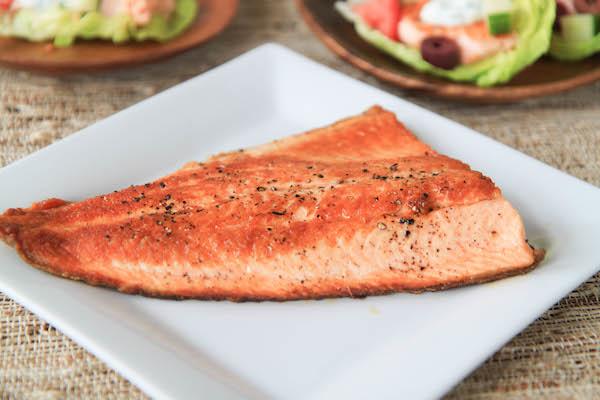When it comes to beef, chicken, and pork, it's fairly easy in the Twin Cities to find local vendors. Whether it's buying a quarter of a cow, fresh pork sausage, or a carton of eggs at the farmers market, or even at some local grocery stores, it's within reach with a little bit of effort. It's also pretty simple to decipher the labels and figure out if you're buying quality meat or not. Seafood, on the other hand, can be a bit trickier.
Since it's difficult (um, impossible?) to find a local tuna or salmon farmer in Minnesota, instead we have to look at labels and talk directly with the source who buys the fish to ensure we are buying sustainable fish.
Seafood can be considered sustainable if the species is abundant naturally or through responsible practice (farm-raised), and the harvesting methods aren't harming natural habitats with pollutants or destroying the habitats in which the species lives.
In addition, contrary to what some might think, this doesn't mean that all seafood needs to be caught in its original habitat and that farm-raised fish is no good. In fact, aquaculture can be a good solution to the pressures put on our ocean, but it needs to be done in a responsible manner, without overfishing, habitat damage, and poor management, according to the Monterey Bay Seafood Watch.
How do we know if the fish we are buying is sustainable? Here are a few simple steps to keep in mind:
Ask questions. I've had great luck with the guys at Whole Foods and Coastal Seafoods. They are incredibly knowledgeable about the seafood they buy and sell and both stores are committed to carrying sustainably sourced fish.
Look for an identifier. At Whole Foods, look for the green label by the wild-caught fish, the blue Marine Stewardship Council eco-label identifying wild-caught seafood products that are MSC-certified, or the "Responsibly Farmed" logo on the farmed fish. You can also check out Whole Food's sustainability rating system.
Use a cheat sheet. If you're not shopping at Whole Foods or a store that has ratings right on their seafood case, be prepared by checking out the Monterey Bay Seafood Watch's pocketbook guide for choosing sustainable seafood. It has a great list of the best choices for sustainable seafood and which ones to avoid. They also have an app for iPhones and Androids called Seafood Watch.

While you might be familiar with a few of the fish on the list above like trout, tilapia, tuna, salmon, and halibut, there might be a few that are new to you. For example: arctic char.
If you're not familiar, arctic char is a cold-water fish similar to salmon, in both look and taste. Today, I'm sharing two recipes, the first is a really easy simple pan-seared char recipe that is simply the process of cooking the fish on a stove top, with just a bit of salt, pepper, and olive oil.
The second recipe uses that pan-seared arctic char in Greek-inspired lettuce cups. Here, the seared char is wrapped up in mini lettuce cups along with tomatoes, cucumbers, kalamata olives, red onion, and finished off with a Tzatziki sauce. These are great as a light dinner, perhaps along with some pita bread and hummus, and would also be a fun appetizer.
Simple Pan Seared Arctic Char
1 large filet of Arctic Char
2 tbsp olive oil
salt and pepper, to taste
Heat oil in large skillet over medium high heat. Add char, skin side down, and cook for five to six minutes, until sides are starting to look opaque. Flip over and cook another three to four minutes. Char is done when it flakes easily with a fork.
Greek Arctic Char Lettuce Wraps
(serves 4 or makes great appetizers)
1 lb Arctic Char, pan seared (recipe above)
butter lettuce cups
2 roma tomatoes, diced
1/2 cup cucumber, diced
1/4 cup red onion, thinly sliced
1/4 cup kalamata olives, sliced
For the Tzatziki:
1 cup Greek yogurt
juice from 1 lemon
2 tbsp fresh dill, chopped
1 clove garlic
1 tablespoon olive oil
1/4 cup cucumber, finely diced
1/2 tsp salt
Make the tzatziki by combining all ingredients together. Refrigerate until ready to use. Assemble by filling the lettuce cups with a small piece of the char, then top with tomatoes, cucumbers, red onion, olives, and a dollop of the tzatziki.
Serve immediately and enjoy!
 Taylor Ellingson is a Minnesota girl who's loving life with her husband Marc and their Golden Retriever Maddie. She loves cooking healthy meals, but it's essential that she has her dessert. All after a hot yoga class or a run, though! It's all about moderation.
Taylor Ellingson is a Minnesota girl who's loving life with her husband Marc and their Golden Retriever Maddie. She loves cooking healthy meals, but it's essential that she has her dessert. All after a hot yoga class or a run, though! It's all about moderation.

